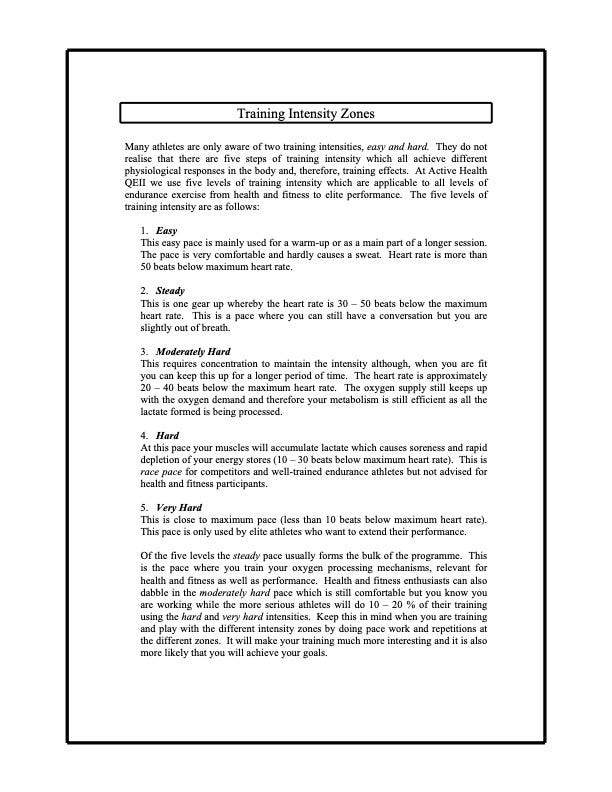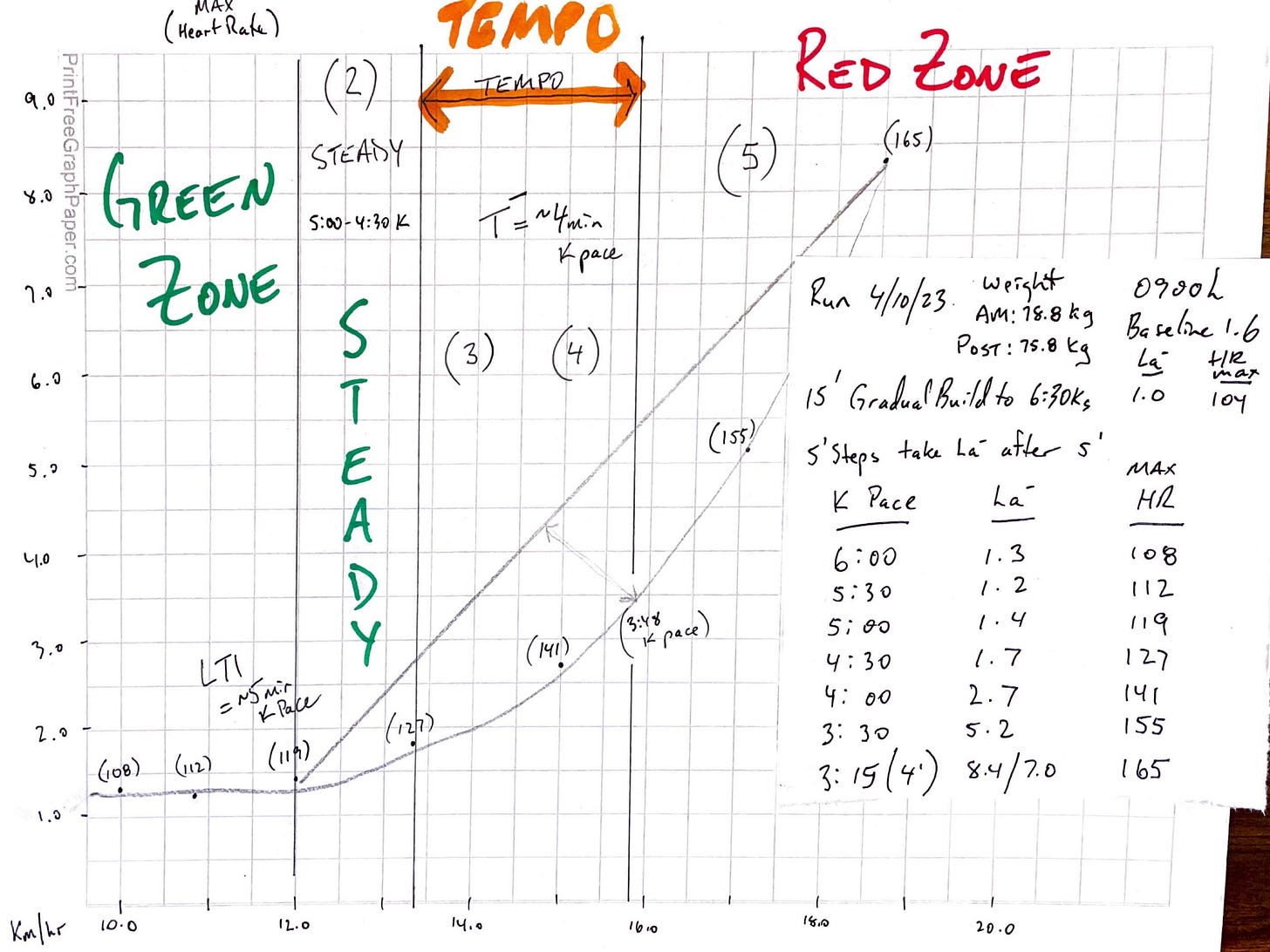Today, we’re going to discuss zones.
Zones can be:
Confusing For Athletes
Frustrating For Coaches
A distraction from what really matters => work over time!
Each of us can feel the key shifts that occur as we move up the intensity profile.
These two articles give you protocols to set the bottom half of your profile:
Your First Track Session (see footnote for swim & bike)1
While using the protocols, notice how four different efforts feel:
Recovery - Well Under LT1 (LT1 is defined below)
Easy - Under LT1
Steady - around, and a little over, LT1
Moderately-Hard / Tempo - light panting begins
Recovery - Easy - Steady - Moderately Hard
A Word On Zone 2
Every single time you read a reference to “Zone X” take time to understand the underlying intensity.
“Zone 2” can mean anything from “Easy” to “Tempo” depending on the country of the author and their preferred Zone System.
Two important things to remember:
Using the Five-Zone System popularized by Joe Friel, common usage of “Zone 2” can refer to anything from Friel Zone 1 to Friel Zone 4.
Two athletes, discussing different zones, might be discussing the same relative intensity. I’ve seen online arguments where the participants didn’t realize they were agreeing.
Linking to the underlying physiology avoids confusion. I prefer to link to the first lactate threshold.
If you don’t have access to lactate testing then consider “How does this intensity relate to my breath markers?”
I recommend you link your Steady Endurance Training to the first lactate threshold and pay attention to heart rate, breathing and feel.
Easy is below that point.
Recovery is further below.
Tempo begins when you feel a light pant begin.
Easy Tempo is a waste of mojo.
As for what zone numbers you assign, I leave the choice to your personal preference.
Frankly, you might be better skipping numbers and referring to Subjective Perception. Most everyone knows the difference between Easy/Steady - Tempo/Hard - Very Hard.
If you have experience with exercise physiology then this Twitter Thread provides additional information on the challenges of seeking an international consensus on Zone 2.
Updating The Training Intensity Handbook
Many years ago, John Hellemans wrote the book, literally, on training intensity zones. Behind the scenes, John and I are working on an update for you.
We are gathering information on current best practices and comparing to our own experience.
We’re reaching out to coaches and scientists. Our aim to deeply understand “the science” and convey it in a way that is easily applied in your training.
When the science is blurry, and consensus lacks, John and I believe we should keep it simple. Training isn’t rocket science. Our zones change, and overlap.
Today’s article is an effort to set the scene and introduce you to terms you will encounter.
To get started, here are the Five Zones John has used for many years in New Zealand. This single sheet of paper has been enough to guide novices through to World Champions.
John’s approach mirrors the Five-Zone System used by Joe Friel.
Both coaches taught me their approach, directly.
It was good enough for me to win an Ultraman World Championship.

Eight-Zone System
If you’re interested in a deep dive on the physiology of zones then Chapter Six of Alan Couzens’ Substack is a must read.
Alan uses an Eight-Zone System.
I view the eight zones as gears spanning the full range of an athlete’s Intensity Profile.
I recommend you link each zone to how it feels in your body.
Recovery / Zone 0
Easy / Zone 1
Steady / Zone 2
Moderately- Hard / Tempo / Zone 32
Hard / Threshold / Zone 4
Very Hard / VO2 / Zone 5
Fast / Zone 6
Very Fast / Zone 7
You will see other coaches using the same system with the zones running Zone 1 to Zone 8.
Often, the same system is presented as a Five-Zone System with the addition of Recovery (on one side) and Fast/Very Fast (on the other).
Alan’s precision in defining terms will help you understand what other authors mean.
Please remember human physiology doesn’t change with what we call it.
Three-Zone System
In his chapter, Alan explains how to simplify your approach using a Three-Zone System.3
Green Zone - Zones 0, 1 & 2
Tempo - Zones 3 & 4
Red Zone - Zones 5, 6 & 7
Stephen Seiler has produced a video on the Three-Zone System. There is a lot of good information packed into seven-minutes.
Including:
Why population averages can’t be used for individuals.4
How age-based predictions can lead us astray.
The Three-Zone System reflects how I train.
Green Zone - The Duration Creates the Difficulty, Athletes Can Repeat The Session Multiple Times Per Week
First Transition Zone - Breathing Rate Comes Up, I Start to Pant
Tempo Zone - Happy Hard - Work Rate Is Up, Breathing I Can Hear, No Burning In The Muscles
Second Transition Zone - Burning In The Muscles, I Would Like To Slow Down, Clock Is Ticking, Don’t Feel Like Talking
Red Zone - Can’t Talk, Very Hard Effort, Extended Recovery From The Session, Don’t Want To Repeat The Next Day
What the Eight-Zone System brings to the party is the ability to guide advanced athletes more accurately, and prevent athletes from nuking themselves via intensity creeping upwards.
Don’t sit in the transition zones - you will feel like you are doing more work but you’re wasting mojo and extending recovery.
No One Truth
There is no one truth (on zones).
Athletic performance comes from work over time, not how we present the program.
Our bodies are changing day-to-day, and as we fatigue during our sessions.
Getting to know breath markers and feeling will help dial in appropriate training efforts.
Feeling changes with time.
Durability
There are rules-of-thumb for for how long an athlete is expected to be able to hold each Training Intensity Zone. Unfortunately, they fail at the individual level.
An individual’s capacity can’t be estimated from the group’s performance.
Further, it is foolhardy to use short duration performance to create long duration pacing strategies.
My article, Durability is Speed You Can Use, goes deeper into durability.
Time reveals true fitness.
Durability is…
...the time of onset and magnitude of deterioration of physiological performance parameters over time during prolonged exercise.
That is a careful and precise way to say…
Zones change based on fitness, fueling and conditions.
Fresh vs Fatigued Zones
Fueled vs Depleted Zones
Hot vs Cold Zones
Humid vs Dry Zones
And Any Other Combination Of Factors
So many variables, different terms for the same things and when we finally arrive at a zone… our fatigue rate changes based on time and conditions.
We can see why experienced coaches teach “feel” to their teams and athletes.
John and I are not intimidated, and you shouldn’t be either. Together, we will figure this out. We will be sharing guidance you can apply for better results.
In Part Two, we start with running. I’m going to lay out a method to track your profile over time.
Back To Table of Contents
Swimmers see Benchmarking Your Swim. Cyclists see Stop Wasting Mojo In Your Grey Zones.
Zone 3 can be referred to as Marathon Pace - which is misleading for a race that can take 2 to 6 hours. Certain terms, that make sense for top athletes, breakdown when applied to the general population.
Getting scientists to agree where, exactly, the zones change is difficult. This is because the zones overlap. Further complicating the discussion, there is a case to be made… there aren’t any thresholds at all.
Individual - Household - Local - Regional - National - Global. An approach that works at one level doesn’t necessarily apply when changing scale. This applies in many areas of our lives.




